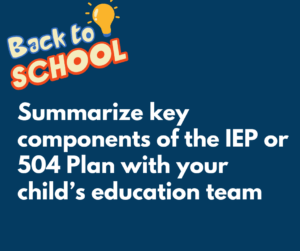Our Education Coordinator, Anna Tess Ed.D knows the importance of back to school and being prepared. As a teacher of the deaf and school principal, Anna wants to make sure students and their parents are well prepared at the beginning of the school year.
Going back to school can make any student anxious, but it can be especially hard for students with hearing loss, so we asked Jen Haney, the Hart Family Cochlear Implant Education Liaison at Ann & Robert H. Lurie Children’s Hospital of Chicago to give us some tips to make the transition from summer to school easier for everyone.
These should help to ensure a positive start to the school year.

Request a beginning of the year meeting with your teacher(s).
This can help you feel more comfortable before the first day of school. Explain your hearing loss and needs. Take a look at the classroom and where it might be best for you to sit. Set up a system between you and your teacher to let them know when you’re struggling to hear.
If your child has a hearing itinerant or teacher of the deaf, they will in most cases provide an in-service to the educational team. Ask to be part of the in-service. If your child does not have special services providers at school, ask to set up a meeting with the staff that will be interacting with your child.

Make sure any necessary technology is ready for the first day of school.
This includes providing extra batteries, hearing assistive technology, streaming devices and any other supplies necessary to ensure your child’s hearing aids/cochlear implants work properly throughout the school day. Help your teacher understand how to utilize the equipment including remote hearing assistive technology (R-HAT) and provide troubleshooting guides.

Advocate for your needs.
Make sure your child is comfortable speaking up if they are having trouble hearing something. This includes asking for interpreting services and / or closed captioning if needed. Make sure your child has the right seating in your classroom and knows that they should sit somewhere where they can hear the speaker. Make sure your that your teacher is aware of your childs assistive technology, and what they may need to help with it. Students should be able to identify when their device is not working and should know to tell the teacher, so they can help work to troubleshoot the issue.

Summarize key components of the IEP or 504 Plan with your child’s education team.
Set up Goals
Go over classroom accommodations and testing accommodations, making sure everything listed on your child’s IEP/504 is being addressed.
Set up a schedule for service minutes.

Ask about related service minutes
If your child receives special services (OT, PT, Speech, Hearing Itinerant Services, etc.), touch base with each provider to ask how will services be provided.
a. Will your child be seen one on one, in a group setting, or will the service provider push-in to classroom?
b. When will service minutes be met? Will they be pulled out during academics, during specials, study halls, etc.?
c. Discuss how will that might impact their day socially and academically.

Set up regular communication with team.
It’s very important to collaborate with the school team. Make sure you discuss and decide on the type and frequency of communication between the team and you.

Be transparent with your classmates.
Educate them on your hearing loss and amplification. Let them know what you need from them to help successfully communicate with each other. Allow them to ask questions….they may be curious and interested in knowing more about you and your hearing loss!

Join a club or sport.
It’s a great way to make new friends that share the same interests. If you need them, there are also accommodations that can be made for your hearing loss that can be made for after school activities, so don’t be afraid to try!
These tips were written by Jen Haney, MA, DT-H, the Hart Family Cochlear Implant Education Coordinator. Jen has been a true patient champion, constantly in contact with families and schools to identify each child’s set of strengths and areas of need so patients have appropriate supports in place.



